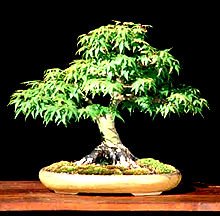The Right Pot? Considerations to Keep in Mind when making that all important choice.
by John B.
Introduction
Those of you who read the Summer 2001 issue of the American Bonsai Society magazine will probably recognize the bonsai which is the subject of this article on pot selection. You’ll remember the tree is a small Japanese maple Acer palmatum ‘Kiyo-hime’.
The pot selection process came about as a result of having severely pruned the maple a few years before. The hard pruning required that the tree be allowed to regenerate, and in effect, become a new bonsai. Having more than one suitable pot to choose from can be a nuisance, because it requires having to make a selection. And once you have to do that, well, there is always the chance of selecting the wrong pot. Nevertheless, it is a good exercise to go through and a lot of fun. So you make a mistake. No big deal. You can always change pots next year, right? Seriously, though, having more than one suitable pot is the way to go because each pot bestows a unique look to your bonsai. So unique, in fact, that people, even close friends, will wonder when you got that “new tree”.
To show how a container will modify the appearance of a bonsai, I will use a series of photographs to illustrate the point.
The maple as it was in late May 1996
The maple as it was before transplanting in late March 1997
First, though, to set the stage. Photo #1 is of the tree in late May 1996 while it was still in its rehab mode. The pot measures, in centimeters: 29 x 20 x 8.5 or 11 3/8 x 8 7/8 x 3 3/8 in inches. Photo #2 shows the tree pruned in March 1997, still in the same pot. It has progressed nicely and is now at the point where it is ready for transplanting into a more deserving container.
The Containers
The first pot I concidered (Photo #3) is oval with convex sides and an inside lip. Its colour is an attractive mix of gold and charcoal, in a matte finish. The texture is smooth, although in appearance there is the suggestion of coarseness. Its dimensions in cm. are 30.5 x 24.5 x 5 (12 x 9 5/8 x 2 inches). The legs are low and wide. The pot is the creation of PET (Petra Engelke Tomlinson) from Nottingham, England.
Pot 1 is oval with convex sides and an inside lip.
Pot 2 is also oval but with a thin band dividing the height of the straight sides.
Pot #2 is also made by Petra. Its dimensions, again in centimeters, are: 27 x 21 x 5.5 (10 5/8 x 8 1/2 x 2 3/16 inches). This pot is also oval with a thin band dividing the height of the straight sides. The legs are low, wide and quite whitish. It has three colours, the first, starting from the top, is cinder-grey. The middle is a drip glaze in teal, and the rest, which is free of the drip glaze, is a dark honey colour. It has a rough feel to it and looks much heavier than the previous pot. The whitish feet are a distraction.
Pot 3 is Tokoname ware. It is fairly rectangular and has straight, and fairly thin, sides with chopped corners.
The third container (Pot #3) is Tokoname ware and has the following dimensions in centimeters: 28 x 22 x 6.5 (or 11 x 8 5/8 x 2 5/8 inches). It is rectangular and has straight, and fairly thin, sides with chopped corners. The feet are tiered and pointy. The glaze is referred to as “almond” and is quite attractive. The glaze is smooth and not glaring. The few tiny imperfections in the clay are a nice feature because they add texture and subtle character to the pot.
Other Considerations
In deciding on which pot to use, I had to also consider some prominent characteristics of the maple. The bark of the Kiyo-hime is primarily green, except for the lower trunk, which is graying up more every year. The emerging foliage in spring, although not a spectacular red, is nevertheless always an attractive reddish hue. Autumn colour is usually nothing to write home about. Mr. Vertrees calls the tree’s summer colour a “rich green.” I shouId grow mine in a more shaded area.
In addition to colour considerations, the tree has two additional dominant visual features: its root spread, and what I consider a massive buttress for a relatively small tree. Both of these features must be accommodated and displayed tastefully in any container chosen. Not necessarily last, the container selected has to be large enough to also take into account the maple’s mature complement of foliage. (Photo #4) All too often the need to do this is forgotten, and as a result, the tree will look too big for the pot by the middle of its growing season.
Make sure that the pot is large enough to be “Right” when the tree has a full complement of foliage. (See next photograph) - May 1998
Finally, and as a bit of a generalization, any bonsai should be in a pot large enough so that the bonsai is not unduly stressed when given normal care.
Selecting the Pot
By now many of you have probably jumped to the last picture so you aIready know the pot I chose. Ah, well. Anyway, here are some of my reasons why I did not pick either Pot #2 or Pot #3, and also my thoughts on why Pot #1 was the best choice. To avoid repeating myself I should say right away that, in terms of size, any of the pots would have been OK to use.
Pot #2 is very attractive and I am using it now with another Japanese maple. For use with the Kiyo-hime, it had several strikes against it. First, its colour cIashed with just about every aspect of the maple, and its coarse texture and drip glaze is deserving of a more rugged tree, despite the fact that the Kiyo-hime has some powerful surface roots. The whitish feet – hopefully they will darken with time – are a visual distraction, especially when seen in a photograph.
Pot #3 I had used with the Kiyo-hime once before in a weak moment. While in the present picture it is not as obvious as I would have liked it to be in showing that the pot is not a good choice, believe me, once potted up it looks like the tree is sitting on the pot instead of in it! It seems to be the pointy feet and formal sides and corners that ruin it for using it with the Kiyo-hime. I like the colour, texture and feel of the pot very much, and look forward to selling it.
“The right choice” - June 2001
Pot #1 is the winner. In my mind’s eye this pot by PET was the perfect fit for the Kiyo-hime. The pot has smooth, simple lines that are very feminine. There is nothing about the pot that, in my view, cIashes with any element of the bonsai, including seasonal colour. In fact, the pot, if you describe the bonsai from the bottom up, provides smooth continuity from pot to soil, to roots and lower trunk, and finally, on to the green trunk and foliage. By adding moss to the soil surface the transition from pot to tree, or tree to pot, if you prefer, is made almost seamIess.
The low appearance of the pot (there is only a difference of 1.5 cm between this pot and the deepest) is a bit of an illusion brought about by the curving sides and wide, low feet. But this low-slung look gives the planting good balance, I think, and at the same time provides understated emphasis to the powerful lower portion of the bonsai. The bonsai is healthy and looks comfortable.
I am sure I will eventually change pots, but… Selecting the pot from a number that are suitable, once you have eliminated size considerations, often seems to defy rational explanation. Next time you look through a bonsai photo album or walk through a bonsai exhibit, ask yourself about the artist’s choice of container and why, if you disagree, you would have chosen something different.








